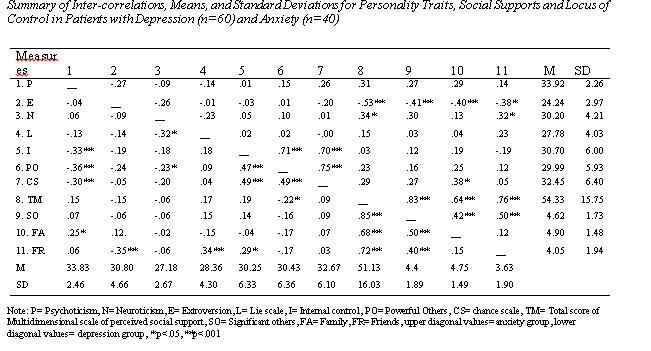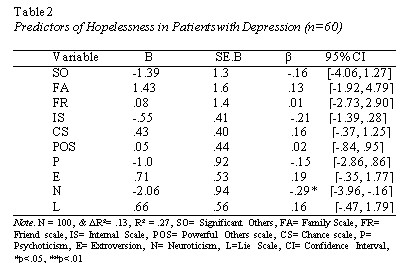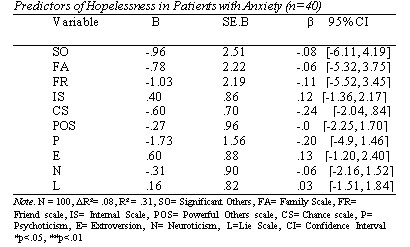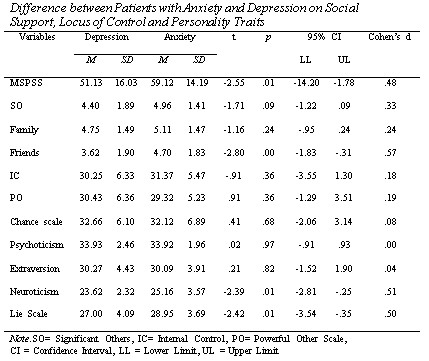Social Support, Locus of Control and Personality Traits as Predictors of Hopelessness among Patients with Depression and Those with Anxiety
Faryal Afzal
Bajwa Hospital, Lahore
*Tehreem Arshad
Centre for Clinical Psychology, University of the Punjab, Lahore
The aim of the present study was to investigate the relationship of social support, locus of control and personality traits among patients of depression and anxiety and to explore these variables as predictor of hopelessness. Purposive sampling was employed to gather data of 100 participants (Depression=60) and (Anxiety=40) from indoor and outdoor psychiatric wards of five teaching hospitals of Lahore. It was hypothesized that there is likely to be a relationship among social support, locus of control and personality traits. Moreover, social supports, locus of control and personality traits are likely to predict hopelessness among patients with anxiety and depression. Multidimensional Scale of Perceived Social Support (MSPSS; Zimet, Dahlem & Farley, 1988), Levenson’s Multidimensional Locus of Control Scale (Levenson, 1988), Eysenck Personality Questionnaire (EPQ; Eysenck & Eysenck, 1975) and The Hopelessness Depression symptom Questionnaire (HDSQ; Metalsky & Joiner ,1997) were employed to assess social support, locus of control, personality traits and hopelessness respectively. The results revealed that there is a negative relationship between locus of control and psychoticism (personality trait) and positive correlation between psychoticism (personality trait) and social support from family among depression patients. Among anxiety patients, there is a positive correlation between perceived social support and neuroticism (personality trait) whereas there is negative relationship between perceived social support and extroversion (personality trait). Furthermore, regression analysis revealed that neuroticism (personality trait) was strongest predictor of hopelessness among depressive patients. While among anxiety patients, none of these variables emerged as predictors of hopelessness.
Keywords: : Social support, locus of control, personality traits, hopelessness, depression, anxiety.
It is of crucial importance to understand the predictive relationship of hopelessness with psychosocial variables in individuals experiencing depression and anxiety disorders because hopelessness is a debilitating emotional symptom that exacerbates pessimism in depressive patients and apprehension in anxiety patients (as cited in Matthews, Deary, & Whiteman, 2003).
Melges and Bowlby (1969) defined hopelessness as a state and a degree in which an individual have negative anticipation regarding his/her future (as cited in Spirito & Overholser, 2003). Hope is person’s will power and power to find his direction and to achieve a goal in life. Hopeful persons keep themselves positive towards the outcomes and stay away from the negative outcomes (Hellriegel & Slocum, 2007). Relationship between hope and hopelessness is like that it exists at two extremes of a continuum (Campbell, 1987). Hopelessness is a major component of depression and suicidal ideation (Beck, Steer, Kovacs, & Garrison, 1985; Weishaar & Beck, 1992). The people with depressive symptoms are more vulnerable towards hopelessness. They have poor medical as well as personal conditions. They endure more psychological problems such as anxiety, panic attacks and phobias etc (Tylee, Priest & Roberts, 1996).
The hopelessness theory speculated that individuals who are vulnerable towards depressive symptoms and have encountered negative events, moved towards hopelessness (Abramson, Metalsky & Alloy, 1989). Alford, Lester, Patel, Buchanan and Giunta (1995) conducted a study on hopelessness and confirmed that depressive symptoms predicted hopelessness. Hopelessness is a belief in which an individual thinks about the problem rather than solution of the problem (Beck, 1976). Individuals with hopelessness keep focusing on negative events and remain far away from positive ones (Jobes, 2006). The personal and social resources play significant role in developing and maintaining hopelessness. For instance, low level of education and financial crisis move a person towards the depressive symptoms and hopelessness (Hussain, Creed & Tomenson, 2000).
Social Support is defined as the perceived caring, appreciation, and assistance from the loved ones and others (Haber, 2001). Social support is an availability of a person at time of need (Jacobson, 1986). Johnson et al. (2001) identified hopelessness as a mediator of association between social support and depressive symptoms, and found out that men as compared to women with low social support are more vulnerable to hopelessness and depression.
According to Heller (1979) social support protects an individual against stressful life events and succeeding illness. Less social support cause depression and anxiety and many several problems related to health (as cited in Whittaker & Garbarin, 1983). Cohen & Wills (1985) illustrated that any kind of social support may lead an individual towards a healthier life, and it also affects their physical as well mental health.
Locus of control is considered to be an essential feature of personality. The concept was developed by Rotter in 1966. It is basically determined whether a person’s life is controlled by oneself or any other external factor involved in it (Rotter, 1966). According to Rotter, people with external locus of control believe that all changes occur due to external or environmental factors, due to their luck or by chance. Whereas the people with internal locus of control believed that all the changes and outcomes are in their own hand (as cited in Sahoo, 2002).
Mutlu, Balbag and Cemrek (2010) studied the role of self-esteem, locus of control and big five personality traits in predicting hopelessness. His study indicates that the students having a personality trait neuroticism is positively associated with hopelessness and have external locus of control as compared to hopeful students.
Eysenck (1976) categorized personality traits into neuroticism, extroversion and psychoticism. As per him, neuroticism trait deals with the characteristics of anxious personality, obsessive attitude and behavior, low self esteem and pessimism towards events. Extroversion is related to the characteristics of individuals who is socially active, irresponsible, risk taker, impulsive, lack reflection and are expressive whereas psychoticism trait indicates the features of dominancy, aggression but assertiveness, goal oriented, ego centric and manipulative (as cited in Eysenck, 1992).
Clark, Beck and Alford (1999) demonstrated that neuroticism plays a great role in the development of anxiety disorder. Various researches interpreted that introversion trait predicted depressive symptoms among the individuals (Levenson, Aldwin, Bosse & Spiro, 1988). Gershuny and Sher (1998) reported that both Introversion and Neuroticism traits interact and predict depressive symptoms. Therefore, it may be concluded that social support, locus of control and personality traits affects psychological illnesses.
This study was carried out to highlight the importance of hope and to identify the level of hopelessness among the patients of depression and anxiety. It helped in identifying and figuring out the type of locus of control among depressive and anxiety patients and recognizing their perception about social support.
Hypotheses
- There is likely to be a relationship between social support, locus of control and personality traits of patients with depression and anxiety.
- Social support, locus of control and personality traits is likely to predict hopelessness among patients with depression and anxiety.
- There is likely to be difference in social support, locus of control and personality traits among patients with depression and anxiety.
Method
Participants
In the present correlation study, purposive sampling was used to collect data from outdoor and indoor patients. Data was collected from five psychiatric wards of Government teaching hospitals of Lahore. The sample comprised of 100 participants (Men=42, Women=58). The total number of patients with depression and those with anxiety was 60 and 40 respectively. Majority of the participants had education till 10th grade.
Measures
Multidimensional scale of perceived social support (MSPSS; Zimet, Dahlem & Farley, 1988). It consists of 12 items and measures three dimensions of social support including family, friends and significant others. Each item is scored on 7 point Likert scale ranging from very strongly disagree (1) to very strongly agree (7). Higher score in any subscale indicates the significant role of that component in perceiving social support. The internal consistency of the subscales ranges from 0.86-0.90 and the whole scale reliability is 0.86 (Rizwan & Aftab, 2009). Permission was taken from the original author and also the author who had translated the tool in Urdu. Urdu translated version of the MSPSS was used for present study. The cronbach alpha of the scale for the present study was 0.83.
Levenson multidimensional locus of control scale (LMLCS; Levenson, 1988). was used to measure participant’s perception about the outcomes of life events. It has 28 items and 2 subscales. The first subscale is Internal Scale which is based on general perception about the outcomes controlled by self. The second subscale is Powerful Others Scale that indicates the control of outcomes by others, and the third subscale is Chance Scale which interprets the outcomes due to luck or chance. Each item is scored on 6 point likert scale ranging from +3 (strongly agree) to -3 (strongly disagree). The internal consistency of the scale is 0.83 and for subscales it ranges from .64-.78 (Levenson, 1988). Urdu translated version of the tool was used for the present study after taking permission from the original author as well as the translating author of the tool. The alpha reliability of this scale in present study was 0.77.
Eysenck personality questionnaire (EPQ; Eysenck & Eysenck, 1975).It has 90 items and comprises of four subscales and measures Extraversion, Neuroticism, Psychoticism and Lie scale. A high score in Extraversion subscale indicates the traits of outgoing, impulsive, uninhibited and social kind of personality whereas high score in Neuroticism indicates strong emotional lability and over reactivity. Elevation in scores of Psychoticism indicates cruel, inhumane, socially indifferent, hostile, aggressive, insular, glacial, less empathetic and intolerant traits. The test-retest reliability of Extraversion was reported to be 0.84, while it was 0.82 for Neuroticism, 0.69 for Psychoticism, and 0.69 for Lie scale. The alpha coefficient of EPQ in present study was 0.75. The test re-test reliabilities of subscales are ranging from 0.78 to 0.84. After seeking permission from the author of EPQ, Urdu version translated by Kausar and Amjad (2001) was used in the present research.
The Hopelessness Depression Symptom Questionnaire (HDSQ; Metalsky & Joiner, 1997). It has 32 items and measures motivational deficit, interpersonal dependency, psychomotor retardation, anergia, apathy/anhedonia, and insomnia, difficulty in concentration /brooding and suicidality. The internal consistency of the complete scale is 0.93, and the alpha values of subscales ranges from 0.70 to 0.86. Each item is scored from 0-3 point scale and higher scores indicated more symptoms of hopelessness depression. After obtaining permission from the author, it was translated in Urdu by the researchers for the present research by following Mapi guidelines. The alpha reliability of HDSQ for the present study was 0.90.
Symptoms Checklist – Revised (SCR; Rahman & Sitwat, 1997). Symptom Checklist-Revised was used to screen out patients with Depression and Anxiety. It comprises of six subscales but in present study, three scales were used: Scale I for Depression which includes 25 items, Scale III was used to measure Anxiety, consisting of 29 items and Scale IV for OCD which comprised of 15 items. The items are rated on four point scale (0= Not at all to 3= Very Much). For psychiatric population the reliability of Depression scale and Anxiety scale are reported to be 0.96 and 0.95 respectively. The validity of Depression and Anxiety scales are 0.73 and 0.47 respectively (Rahman & Jagir, 2000). The alpha reliability for the present study of SCR for depression and anxiety was .82 and .86 respectively.
Procedure
Data was collected from five psychiatric wards of Government teaching hospitals in Lahore. Permission from the concerned medical superintendents of the hospitals was taken for the purpose of gathering data. After taking consent from each participant, the questionnaires were administered. The participants who had received diagnosis from respective psychiatrists of the hospitals and were further screened out by administering the subscales of Anxiety, Depression and Obsessive Compulsive Disorder of Symptom Checklist-Revised. The participants who scored than the cutoff scores on these scales were included in the study.
After the selection of the targeted population, informed consent was taken from the participants. Information regarding the right to withdraw, use of data for only research purpose along with anonymity and confidentiality was communicated to each participant individually.
Table I depicts a negative correlation between Locus of Control and Psychoticism (personality trait) in patients with depression. Furthermore, in depressed patients perceived social support from family is positively correlated with psychoticism (personality trait). There is a positive correlation between internal Locus of Control and perceived social support from friends. In anxiety patients, neuroticism is positive correlated with perceived social support and extroversion (personality trait) is negatively correlated with perceived social support.
Results
Table 1 depicts that a negative correlation between Locus of control and psychoticism (Personality Traits) in patients with depression. Furthermore, in depressed patients perceived social support from family is positively correlated with psychoticism (personality trait). There is a social support from friends. In anxiety patients, neuroticism is positive correlated with perceived social support and extroversion (personality trait) is negatively correlated with perceive d social support.
Table 1 

Table 2 indicates that neuroticism personality trait emerged as the strongest predictor of hopelessness in patients with depression.
Table 3 
Table 3 shows that none of the variable significantly predicted hopelessness in patients with anxiety.
Table 4 
As shown in the table 4, anxiety patients reported significantly more social support (support from friends) as compared to depression patients. On the other hand, significantly more neuroticism was reported by anxiety patients as compared to depressed ones.
Discussion
The aim of the study was to explore social support, locus of control and personality traits as predictor of hopelessness among patients with depression and anxiety. The findings of the present study supported the first hypothesis as among depression patients, there was a significant negative correlation between extroversion (personality trait) and social support by friends. Findings of the present study are consistent with the past researches as it revealed that low level of extraversion predicted high perception of social support (Swickert & Hittner, 2010; Foster & Clarke, 2004). Thus findings of the present study highlighted that extrovert individuals are socially active but score high in depressive symptoms, which indicates that they perceive less support but need more emotional and tangible support from their families and significant others, which could contribute towards depressive symptoms.
The correlation analysis in table I indicated negative correlation between Locus of Control and Psychoticism (personality trait) among depressive patients. Previous studies have also shown that individuals who have high externality or high scores on powerful others scale of locus of control are more vulnerable towards depression due to negative perception of future outcomes as they believe their life circumstances to be out of their control, and they are also less socially active (Hurrell & Murphy, 1991; Smith & Williams,1992; Kline,1993). Individuals with psychoticism have minimum belief on oneself and others. The negative relationship between psychoticism and locus of control indicates that the individual characterized by assertiveness, egocentric, aggressive, manipulative and unsympathetic traits, do not belief in self due to their lack of assertiveness; blame others due to their aggressive and unsympathetic character; and have minimum belief on chances due to their egocentric nature.
Positive correlation was found between internal locus of control and perceived social support from friends. It indicated that those individuals have more friends and share a good quality of relationship with them, who consider themselves confident and avoid blaming others in negative situations. Voils, Steffens, Flint and Bosworth (2005) reported that among patients of depression there is an association between internal locus of control and family interactions. Hence, it could be concluded that high internal Locus of Control among depressive patients leads to high perception of family support, and better relationships. When blame is skipped out of interactions with family and friends, relationships prosper.
Present study found that there is negative correlation in extroversion and perceived social support. Similarly, Clarke (2004) suggested that low level of extraversion predicted less perceived social support. It is easy for an extrovert to gain more social support as they like interacting with others, while an introvert is likely to keep things to oneself and one of this reasons for this can be perceiving people as less supportive.
Second hypothesis was concerned with the significant role of social support, locus of control and personality traits as predicting hopelessness among depression and anxiety patients. The results of regression analysis revealed that neuroticism is a strongest predictor (- .29) of hopelessness among depressive participants. Finding of the present study is supported by the previous researches as Chioqueta (2005) reported that depressive symptoms are positively associated by Neuroticism. Moreover, Mutlu and colleagues (2010) found positive relationship between neuroticism and hopelessness. For this reason, the individuals with traits of psychoticism and neuroticism are more vulnerable towards hopelessness. Barnhofer and Chittka (2009) found that neuroticism increases the vulnerability of an individual towards depression by constantly lowering the mood which increases the risk of hopelessness. The results of this study are in line with the results of the present study. Individual having emotional instability and over reactivity associated with neuroticism are more vulnerable towards psychiatric illnesses. Psychoticism characterized by hostility, aggression and inhumanity in the individual will lead them towards depression and anxiety.
The differences between depression and anxiety patients were also explored by independent t-test. This hypothesis was partially accepted as there was no major difference in reference to locus of control among depression and anxiety patients. It indicates that both anxiety and depression patients have not reported any particularly different locus of control.
Significant differences were found among anxiety patients with regards to neuroticism trait. This is supported by various studies that neuroticism and anxiety symptoms have positive relationship with each other (Muris, Jong & Engelen, 2004; Muris, Roelofs, Rassin, Franken & Mayer, 2005). As the trait of neuroticism is characterized by insecurity and negative feelings towards future, it causes an individual to feel anxious (Rachman, 2004; Carver & Scheir, 2002).
Results of the present study also revealed that anxiety patients have significant difference in perceiving social support by friends as compared to the depression patients. Anxiety patients have more social activities as compared to depressive. It might be explained by the fact that anxiety patients indulge them more in social activities to avoid negative outcomes ones; hence, their perception of perceived support is high. Whereas the depressive patient’s low interest and sad mood decreases their interest in surroundings and social activities.
Limitations & Suggestions
The data was comprised of 100 participants taken from government teaching hospitals only thus limiting the generalizability of the results. Future studies could also include patients from private clinics and hospitals too. Moreover, use of indigenous tools to measure the research variables would improve the quality and validity of the prospective research results.
Future Implications
The finding of the current study indicates that neuroticism trait is higher among anxious participants as compared to depressive ones. There is a need to study about individual characteristics of personality traits that are more vulnerable towards hopelessness that leads towards depression and anxiety in order to better equip clinicians so that timely interventions may be made. Further research can be conducted to examine these variables in different psychological illnesses (as in OCD and phobias).
Conclusion
Results indicated that personality trait specifically neuroticism was strongest predictor of hopelessness among depression and anxiety patients. The people who perceived less social support had higher tendency to be hopeless. However, locus of control does not significantly predict hopelessness among depression and anxiety patients. On the other hand, the participants having personality traits of neuroticism and extroversion showed more symptoms of hopelessness. As far as the comparison between depressive and anxious patients is concerned, it can be concluded from the present findings that anxious patients perceive more social support as compared to depressive ones. Neuroticism (personality trait) is higher among anxiety patients as compared to depressive patients. Furthermore, high score on neuroticism trait predicted more vulnerability towards hopelessness. Therefore, clinicians must be keep these findings in mind while assessing patients and planning interventions.
References
Abramson, L.Y., Metalsky, G. I., & Alloy, L.B. (1989). Hopelessness depression: A theory-based subtype of depression. Psychological Review, 96, 358-372.
Alford, B.A., Lester, J.M., Patel, R.J., Buchanan, J.P., & Giunta, L.C.(1995). Hopelessness predicts future depressive symptoms: a prospective analysis of cognitive vulnerability and cognitive content specificity. Journal of Clinical Psychology, 51(3), 331- 339.
Barnhofer & Chitika (2009). Cognitive reactivity mediates the relationship between neuroticism and depression. Behav Res Ther, 48(4), 275–281. doi: 10.1016/j.brat.2009.12.005
Beck, A.T. (1976). Cognitive therapy and the emotional disorders. International Universities Press, Inc.
Beck, A.T., Steer, R.A., Kovacs, M. & Garrison, B. (1985). Hopelessness and eventual suicide: a 10-year prospective study of patients hospitalized with suicidal ideation. American Journal of Psychiatry,142(5), 559-563.
Campbell, I. (1987). Hopelessness: A concept analysis. Journal of Psychological Nursing and Mental Health Services, 25 (2), 19-22.
Carver, C.S. & Scheier, M.F. (2004). Perspectives on Personality (5th ed). Boston, MA: Allyn & Bacon.
Chioqueta, A.P. (2005). Personality traits and the development of depression, hopelessness, and suicide ideation. Personality and Individual Differences, 38, 1283-1291.
Clark, D.A., Beck, A.T., & Alford, B (1999). Scientific foundations of cognitive theory and Therapy of depression. Canada: John Wiley & Sons, Inc.
Clarke, D. (2004). Neuroticism: moderator or mediator in the relation between Locus of control and depression? Personality and Individual Differences, 37, 245-258. doi:0.1016/j.paid.2003.08.015
Cohen, S., & Wills, T.A. (1985). Stress, social support, and the buffering hypothesis. Psychological Bulletin, 98, 310-357. doi:10.1037 /0033-2909.98.2.310
Eysenck, H.J. (1992). Four ways five factors are not basic. Personality and Individual Differences, 13, 667-673.